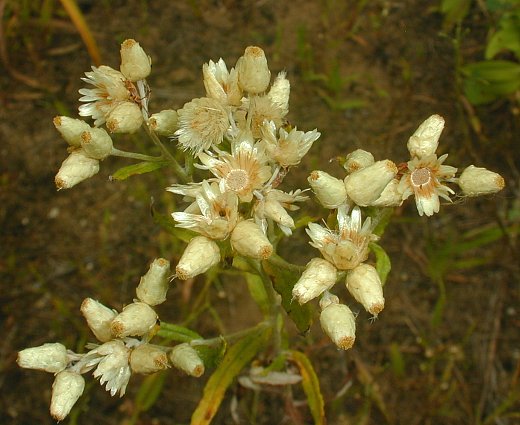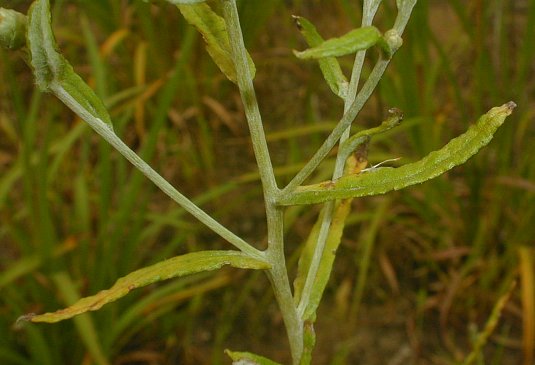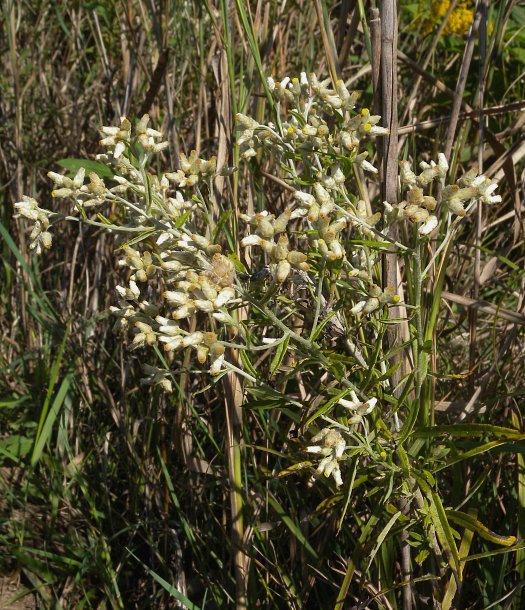Description: This plant is a summer annual or biennial that is erect and eventually becomes ¾–2½' tall. Some plants overwinter as a low rosette of leaves, while others complete their growth and development within a single year. After the rosette stage has passed, each plant has a central stem that is unbranched in the lower half, while short ascending branches develop in the upper half. The central and upper stems are whitish green to nearly white from the appressed woolly hairs that cover their surfaces. The alternate leaves are up to 3" long and 1/3" (8 mm.) across, becoming slowly smaller as they ascend the stems. The leaves are linear-oblong, smooth or minutely undulate along their margins, and sessile. The upper surface of each leaf is mostly hairless and dark green to yellowish green, while the lower surface is whitish green and covered with appressed woolly hairs. Each leaf has a prominent central vein.

Each mature plant terminates in a flat-headed panicle of flowerheads; each panicle is made up of several small corymbs of 2-5 flowerheads. Individual flowerheads are ¼" (6 mm.) long, about half as much across, and white to cream-colored; they are conical-oblongoid in shape with truncate apices. Later, the flowerheads become wider and more open as their achenes become mature. The sides of each flowerhead consist of many overlapping bracts that are white or cream-colored; these scale-like bracts are oblong-lanceolate to broadly oblong-lanceolate and they have blunt tips. At the apex of each flowerhead, there are many disk florets that are pale yellow to light brown; the innermost florets are perfect (both staminate and pistillate), while the remaining florets are pistillate. Each tiny floret is narrowly tubular. The blooming period occurs from late summer to early fall and lasts about a month. There is no noticeable floral scent, although the foliage often has a balsam-like fragrance.

Each floret is replaced
with a small bullet-shaped achene
that has a tuft of white hairs at its apex. These hairs can separate
from each other individually or in small groups; they are not united at
the base. The root system is mostly fibrous. This plant spreads by
reseeding itself.
Cultivation:
The preference is full sun, mesic to dry conditions, and a friable soil
containing sand or silt. A little shade is tolerated. The seeds require
light to germinate.
Range & Habitat:
The native Sweet Everlasting is occasional to locally common throughout
Illinois
(see Distribution
Map). Habitats include upland prairies, sand prairies,
typical savannas and sandy savannas, fallow fields, and areas along
railroads and roadsides. Disturbed dry areas with scant vegetation are
preferred.

Faunal
Associations:
The nectar of the flowers attracts short-tongued bees (mainly
Halictid), wasps, and flies primarily. Among the wasps, are such
visitors as Eumenine wasps, Crabronid wasps, paper wasps (Polistes
spp.), spider wasps (Pompilidae), cuckoo wasps (Chrysididae), weevil
wasps (Cerceris spp.), and many others (see Robertson, 1929). The
Wild Turkey reportedly eats the foliage. White-Tailed Deer browse on
the foliage during the winter.
Photographic Location:
At the edge of a restored sand prairie at Heron Park in Vermilion
County, Illinois.

Comments: This curious plant has woolly foliage and flowerheads that resemble those of Antennaria spp. (Pussytoes), Anaphalis margaritacea (Pearly Everlasting), Gamochaeta purpurea. (Early Cudweed), and some other members of the Aster family. Sweet Everlasting is more tall than Pussytoes and Early Cudweed, and its truncate-conical flowerheads are more narrow than the button-like flowerheads of Pearly Everlasting. There are other Pseudognaphalium spp. in the United States that are quite similar in appearance to Sweet Everlasting, but they have not been observed in Illinois. However, some of these species have been found in neighboring Indiana and other states further to the east. Sweet Everlasting's older scientific name is Gnaphalium obtusifolium (by which it is still commonly referred), but it has been reassigned to the genus Pseudognaphalium.